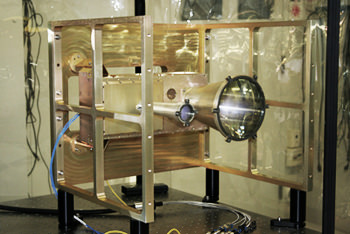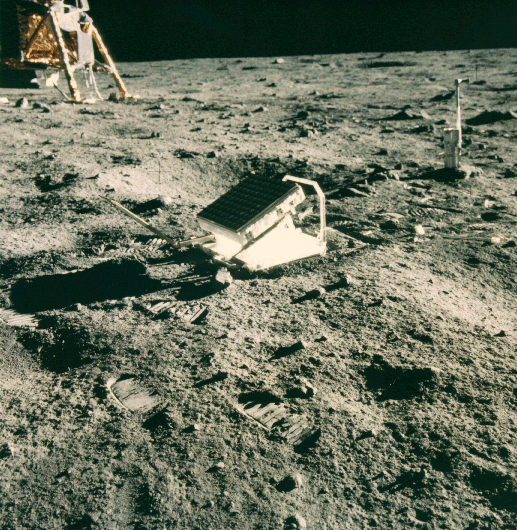[/caption]
The recent images released by the Lunar Reconnaissance Orbiter of the Apollo landing sites are truly remarkable. But there is one instrument on board LRO that must avoid studying some of the the Apollo sites as well as other places where humans have placed spacecraft on the the lunar surface. The Lunar Orbiting Laser Altimeter (LOLA) pulses a single laser beam down to the surface to create a high-resolution global topographic map of the Moon. However, LOLA is turned off when it passes over the Apollo sites because bouncing the laser off any of the retro-reflective mirrors on experiments left by the astronauts might damage the instrument.
Don Mitchell, who owns a software consulting company and is writing a book on the Soviet Exploration of Venus, wrote about this problem on his blog, saying that if LOLA’s beam did strike the retro reflector experiment, “the light bounced back would be 1,000 times the detector damage threshold.”

The LOLA instrument is based on Mars Orbiter Laser Altimeter (MOLA), flown on Mars Global Surveyor and the Mercury Laser Altimeter (MLA), currently on MESSENGER. LOLA will perform the same type of work as these previous instruments, but with 3-5 times greater vertical accuracy and 14 times more measurements along the spacecraft ground track.
The Laser Ranging Retroreflector experiment was deployed on Apollo 11, 14, and 15. It consists of a series of corner-cube reflectors, which reflects an incoming light beam back in the direction it came from.
Ever since the experiments were deployed, the McDonald Observatory in Texas has beamed a laser at these mirrors and measured the round-trip of the beam. This provides accurate data on the Moon’s orbit, the rate at which the Moon is receding from Earth (currently 3.8 centimeters per year) and variations in the rotation of the Moon. These are the only Apollo experiments that are still returning data. A similar device was also included on the Soviet Union’s Lunakhod spacecraft.
David E. Smith, LOLA principal investigator confirmed that, indeed, LOLA is switched off over the Apollo and Lunakhod sites, to avoid damaging the instrument. He said the Russians have been very helpful in in providing the LOLA team the best known locations for the two Lunokhod landers. Lunokhod-2 has been located precisely and is routinely probed by lasers from Earth. Lunokhod-1 has never been found by laser, and it is not known for certain if its reflector is deployed. Smith said he and co-PI Maria Zuber have visited Moscow to consult with Russian scientists, who have shared their knowledge of the locations of their landers.
As Mitchell wrote, “While conspiracy nuts debate the reality of the Apollo landings, scientists must deal with some practical consequences of what astronauts put on the Moon.”
Sources: Don Mitchell’s Blog, email exchange with David E. Smith
Hat tip to Emily Lakdawalla on Twitter!


This did actually cross my mind when I heard that a laser altimeter would be deployed on LRO. Of course NASA has it covered, but damn it would be a big ‘oops’ if they’d forgotten!
in the case of the landing sites, it’s not needed anyhow.